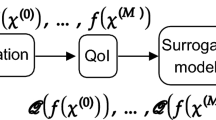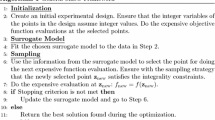Abstract
Large scale, multidisciplinary, engineering designs are always difficult due to the complexity and dimensionality of these problems. Direct coupling between the analysis codes and the optimization routines can be prohibitively time consuming due to the complexity of the underlying simulation codes. One way of tackling this problem is by constructing computationally cheap(er) approximations of the expensive simulations that mimic the behavior of the simulation model as closely as possible. This paper presents a data driven, surrogate-based optimization algorithm that uses a trust region-based sequential approximate optimization (SAO) framework and a statistical sampling approach based on design of experiment (DOE) arrays. The algorithm is implemented using techniques from two packages—SURFPACK and SHEPPACK that provide a collection of approximation algorithms to build the surrogates and three different DOE techniques—full factorial (FF), Latin hypercube sampling, and central composite design—are used to train the surrogates. The results are compared with the optimization results obtained by directly coupling an optimizer with the simulation code. The biggest concern in using the SAO framework based on statistical sampling is the generation of the required database. As the number of design variables grows, the computational cost of generating the required database grows rapidly. A data driven approach is proposed to tackle this situation, where the trick is to run the expensive simulation if and only if a nearby data point does not exist in the cumulatively growing database. Over time the database matures and is enriched as more and more optimizations are performed. Results show that the proposed methodology dramatically reduces the total number of calls to the expensive simulation runs during the optimization process.






Similar content being viewed by others
References
Allen NA, Shaffer CA, Vass MT, Ramakrishnan N, Watson LT (2003) Improving the development process for eukaryotic cell cycle models with a modeling support environment. Simulation 79:674–688
Ames AL, Nadeau DR, Moreland JL (1996) VRML 2.0 Sourcebook, 2nd edn. Wiley, New York, pp 241–295
Burnett T, Chaput C, Arrighi H, Norris J, Suson DJ (2000) Simulating the Glast satellite with Gismo. IEEE Comput Sci Eng 2:9–18
Bramley R, Gannon D, Stuckey T, Villacis J, Akman E, Balasubramanian J, Breg F, Diwan S, Govindaraju M (1998) The linear system analyzer, technical Report TR-511. Department of Computer Science, Indiana University, Bloomington, IN
Boisvert RF, Rice JR (1985) Solving elliptic problems using ELLPACK. Springer, New York
Chen JX, Fu X (1999) Integrating physics-based computing and visualization: modeling dust behavior. IEEE Comput Sci Eng 1:12–16
Dymond R, Lohani V, Kibler D, Bosch D, Rubin EJ, Dietz R, Chanat J, Speir C, Shaffer CA, Ramakrishnan N, Watson LT (2003) From landscapes to waterscapes: a PSE for landuse change analysis. Eng Comput 19:9–25
Eldred MS, Hart WE (1998) Design and implementation of multilevel parallel optimization on the intel teraflops. Multidiscip Anal Optim 98:44–54
Gallopoulos E, Houstis E, Rice JR (1994) Computer as thinker/doer: problem solving environments for computational science. IEEE Comput Sci Eng 1:11–23
Goel A, Phanouriou C, Kamke FA, Ribbens CJ, Shaffer CA, Watson LT (1999) WBCSim: a prototype problem solving environment for wood-based composites simulations. Eng Comput 15:198–210
Guisset P, Tzannetakis N (1997) Numerical methods for modeling and optimization of noise emission applications. In: Proceedings of the ASME international mechanical engineering congress and exposition, ASME FAIRFIELD, NJ, (USA), vol 24, pp 315–322
Goel A, Baker CA, Shaffer CA, Grossman B, Mason WH, Watson LT, Haftka RT (2001) VizCraft: a problem solving environment for aircraft configuration design. IEEE Comput Sci Eng 3:56–66
Giunta AA, Richards MD, Cyr EC, Swiler LP, Brown SL, Eldred MS (2006) Surfpack version 1.0 user’s manual. Sandia National Laboratories, Albuquerque
Giunta AA, Swiler LP, Brown SL, Eldred MS, Richards MD, Cyr EC (2006) The Surfpack software library for surrogate modeling of sparse irregularly spaced multidimensional data. In: 11th AIAA/ISSMO multidisciplinary analysis and optimization conference, AIAA 1708-1736, Portsmouth, VA
Houstis E, Gallopoulos E, Bramley R, Rice JR (1997) Problem solving environments for computational science. IEEE Comput Sci Eng 4:18–21
Kamke FA, Wilson JB (1985) Computer simulation of a rotary dryer: retention time. Am Inst Chem Eng J 32:263–268
Kamke FA, Wilson JB (1985) Computer simulation of a rotary dryer: heat and mass transfer. Am Inst Chem Eng J 32:269–275
Myers RH, Montgomery DC (1995) Response surface methodology, process and product optimization using designed experiments. Wiley, New York
Mishra D, Shaffer CA, Ramakrishnan N, Watson LT, Bae KK, He J, Verstak A, Tranter WH (2007) S4W: a problem solving environment for wireless system design. Softw Pract Exp 37:1539–1558
Pérez VM, Renaud JE, Watson LT (2001) Adaptive experimental design for construction of response surface approximation. AIAA 40:2495–2503
Pérez VM, Renaud JE, Watson LT (2008) Reduced sampling for construction of quadratic response surface approximations using adaptive experimental design. Eng Comput 25:764–782
Pérez VM, Renaud JE, Gano SE (2000) Constructing variable fidelity response surface approximations in the usable feasible region. In: Proceedings of the 8th AIAA/NASA/USAF multidisciplinary analysis & optimization symposium, AIAA 2000-4888, Long Beach, CA
Pérez VM, Renaud JE (2000) Decoupling the design sampling region from the trust region in approximate optimization. In: Proceedings of the international mechanical engineering congress and exposition, American Society of Mechanical Engineers, vol 63, pp 205–214
Rodríguez JF, Perez VM, Padmanabhan D, Renaud JE (2001) Sequential approximate optimization using variable fidelity response surface approximations. Struct Multidiscip Optim 22:24–34
Rodríguez JF, Renaud JE, Watson LT (1998) Trust region augmented Lagrangian methods for sequential response surface approximation and optimization. J Mech Design 120:58–66
Resnik J, Kamke FA (1998) Modeling the cure of adhesive-wood bonds using high frequency energy. Final Report, U.S.-Slovene Joint Board on Scientific and Technological Cooperation, Project 95-AES10. University of Ljubljana, Ljubljana
Rodríguez JF, Renaud JE, Watson LT (1998) Convergence of trust region augmented Lagrangian methods using variable fidelity approximation data. Struct Optim 15:141–156
Renaud JE, Gabriele GA (1994) Approximation in nonhierarchic system optimization. AIAA J 32:198–205
Shu J, Watson LT, Ramakrishnan N, Kamke FA, Zombori BG (2004) An experiment management component for the WBCSim problem solving environment. Adv Eng Softw 35:115–123
Shu J, Watson LT, Ramakrishnan N, Kamke FA, North C (2008) Unification of problem solving environment implementation layers with XML. Adv Eng Softw 39:189–201
Shu J, Watson LT, Zombori BG, Kamke FA (2006) WBCSim: an environment for modeling wood-based composites manufacture. Eng Comput 21:259–271
Sioson A, Watkinson JI, Vasquez-Robinet C, Ellis M, Shukla M, Kumar D, Ramakrishnan N, Heath LS, Grene, R, Chevone BI, Kafadar K, Watson LT (2003) Expresso and chips: creating a next generation microarray experiment management system. In: Proceedings of the next generation software workshop, Los Alamitos, California, USA
Skidmore R, Verstak A, Ramakrishnan N, Rappaport TS, Watson LT, He J, Varadarajan S, Shaffer CA, Chen J, Bae KK, Jiang J, Tranter WH (2004) Towards integrated PSEs for wireless communications: experiences with the S4W and SitePlanner projects. ACM SIGMOBILE Mobile Comput Commun Rev 8:20–34
Tong SS, Powell D, Goel S (1992) Integration of artificial intelligence and numerical optimization techniques for the design of complex aerospace systems. In: Proceedings of the aerospace design conference, AIAA 92-1189, Irvine, CA
Thacker WI, Zhang J, Watson LT, Birch JB, Iyer MA, Barry MW (2009) Algorithm XXX: SHEPPACK: modified Shepard algorithm for interpolation of scattered multivariate data. Technical Report TR 09-13, Department of Computer Science, Virginia Polytechnic Institute & State University, Blacksburg, VA 24061
Vanderplaats Research and Development, Inc. (1985) DOT users manual. Version 4.20, Colorado Springs, CO
Vass M, Allen N, Shaffer CA, Ramakrishnan N, Watson LT, Tyson JJ (2004) The JigCell model builder and run manager. Bioinformatics 20:3680–3681
Vass M, Shaffer CA, Ramakrishnan N, Watson LT, Tyson JJ (2006) The JigCell model builder: a spreadsheet interface for creating biochemical reaction network models. IEEE/ACM Trans Comput Biol Bioinforma 3:155–164
Watson LT, Lohani VK, Kibler DF, Dymond RL, Ramakrishnan, N, Shaffer CA (2002) Integrated computing environments for watershed management. J Comput Civil Eng 16:259–268
Wolfram S (1996) The mathematica book, 3rd edn. Wolfram Media/Cambridge University Press, Champaign
Wujek BA, Renaud JE (1998) New adaptive move-limit management strategy for approximate optimization, part 1. AIAA J 36:1911–1921
Wujek BA, Renaud JE (1998) New adaptive move-limit management strategy for approximate optimization, part 2. AIAA J 36:1922–1937
Zombori BG, Kamke FA, Watson LT (2001) Simulation of the mat formation process. Wood Fiber Sci 33:564–579
Zombori BG, Kamke FA, Watson LT (2003) Simulation of internal conditions during the hot-pressing process. Wood Fiber Sci 35:2–23
Zombori BG, Kamke FA, Watson LT (2004) Sensitivity analysis of internal mat environment during hot-pressing. Wood Fiber Sci 36:195–209
Acknowledgments
This work was supported in part by Department of Energy Grant DE-FG02-06ER25720, Air Force Research Laboratory Grant FA8650-09-2-3938, National Science Foundation Grant CCF-0726763, and Air Force Office of Scientific Research Grant FA9550-09-1-0153.
Author information
Authors and Affiliations
Corresponding author
Rights and permissions
About this article
Cite this article
Deshpande, S., Watson, L.T., Shu, J. et al. Data driven surrogate-based optimization in the problem solving environment WBCSim. Engineering with Computers 27, 211–223 (2011). https://doi.org/10.1007/s00366-010-0192-8
Received:
Accepted:
Published:
Issue Date:
DOI: https://doi.org/10.1007/s00366-010-0192-8




